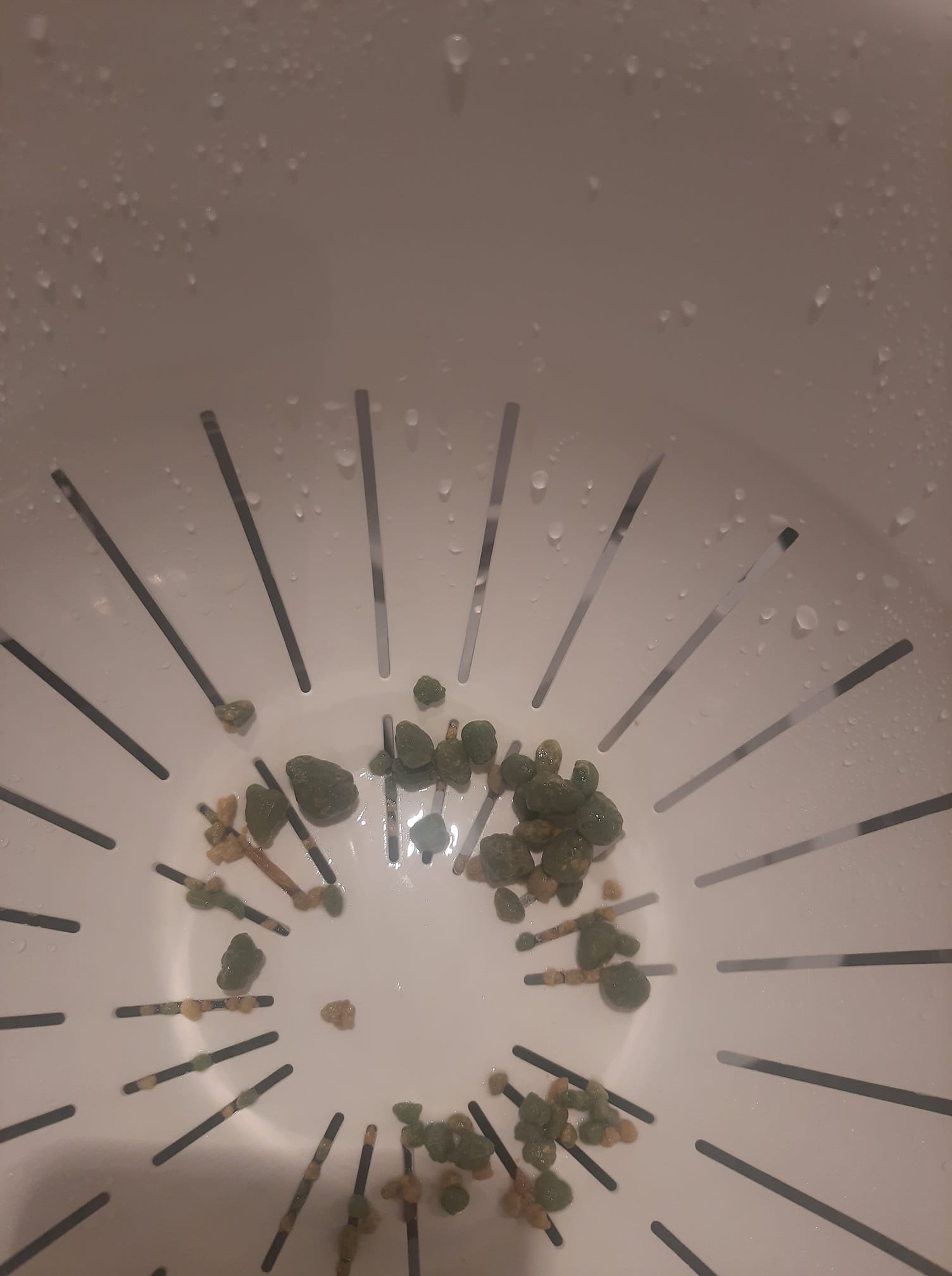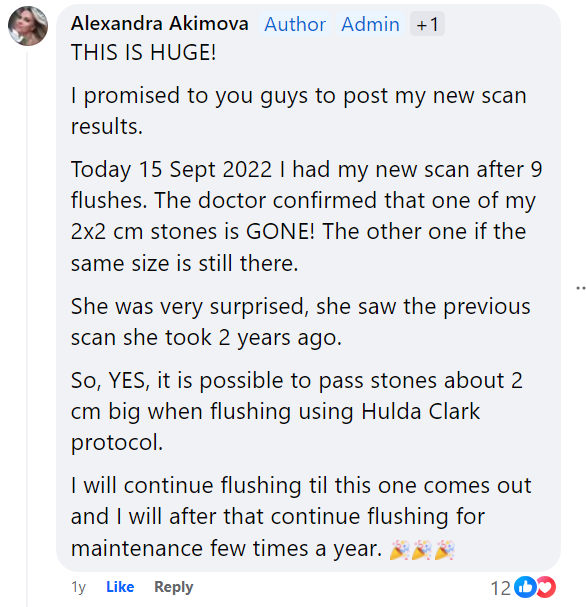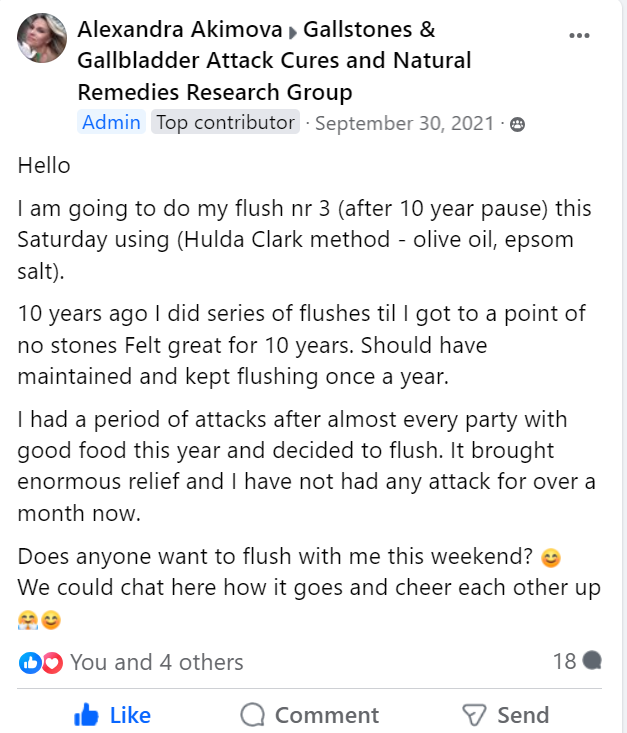





Here one from the literature
http://www.curezone.org/forums/am.asp?i=2325087
Here is a testimonial with pictures of a stone almost the size of a golf ball. Look at flush number 21.
http://www.drclark.net/en/documented-testimonials/liver-cleanse-documented-testimonials/970-results-of-21-liver-cleanses
We have all heard it almost every time someone mentions liver flush:
Gallstones can not be expelled from gallbladder!
Fact or Fiction?
Is there any solid evidence that Gallstones can exit gallbladder?
If there was any solid evidence that Gallstones can exit gallbladder, why would any doctor claim that gallstones CAN NOT exit gallbladder?
Answer: Fact and Fiction.
Fact: Some gallstones can exit gallbladder.
Fiction: All gallstones can exit gallbladder. (Rare stones can be even larger then 2 inch (5Cm) in smallest diameter)
Fiction: Gallstones can not exit gallbladder.
(Anyone believing that no stone can exit gallbladder is ignorant/uninformed or plain wrong.)
Stones can be smaller then 2 mm in diameter, and could easily travel through bile ducts, without causing obstruction, pain or any symptoms).
In rare occasions, bile ducts can be extermely large, significantly larger then 2mm across, allowing stones, sometimes as large as 1cm across smallest diameter to travel through the ducts and to exit into intestines.
Every stone starts it's life as a microscopic crystal of cholesterol. Very few gallstones ever get a chance to grow larger then 2mm. Most are expelled while microscopic or while as small as sand.
cholesterol = chole + sterol
The name originates from the Greek chole- (bile) and stereos (solid)
cholesterol = Greek for solid bile
How do we know that some gallstones can exit gallbladder?
Medical science! Obstruction of the common bile duct is often caused by gallstones that were expelled from the gallbladder:
http://www.ncbi.nlm.nih.gov/entrez/query.fcgi?cmd=Retrieve&db=PubMed&...
In patients with chronic Pancreatitis, common bile duct obstruction is reported in 3.2-45.6% of patients; however, only 5-10% of all patients with chronic Pancreatitis require operative decompression of the bile duct.
http://www.virtualgastrocentre.com/diseases.asp?did=191
Passage of gallstones into the common bile duct occurs in approximately 10-15% of patients with Gallstones. The incidence is thus related to the presence of gallstones, which are very common (10-20% of population).
http://www.pubmedcentral.nih.gov/articlerender.fcgi?artid=1119388
Jaundice occurs in patients with gall stones when a stone migrates from the gall bladder into the common bile duct...
Let us do some math here.
20% of people in USA may develop gallstones during their life
15% of people in USA with gallstones may experience obstruction of the common bile duct
How many people in USA may experience obstruction of the common bile duct?
Answer: 3% of the total population where 20% may develop gallstones during lifetime.
What about USA?
Population of USA: 300 million.
How many people may experience obstruction of the common bile duct during their life?
3% = 9 million people in USA will experience obstruction of the common bile duct with gallstone(s), gallstone(s) that most likely was/were formed inside gallbladder, and then expelled, only to be stuck into the common bile duct.
9 million reasons why doctrors claiming gallstones can not exit gallbladder are wrong!
Question: Do all gallstones expelled from gallbladder end-up blocking common bile duct?
Answer: No, only gallstones that have specific size and/or specific shape.
How many gallstones have that specific size and/or shape that would allow it to exit gallbladder, but would not allow it to pass through common bile duct or through the "sphincter of oddi"?
Nobody knows the answer to this question.
But, we could estimate that less then 10% of all stones would qualify.
In other words, 90% of gallstones (or gallbladder sand and sludge ) that exits gallbladder does not stuck in the common bile duct, and will never be registered.
What does that mean? Majority of people with gallstones have expelled some of their stones at one time or another, without ever knowing it happened. Stones pass from bile ducts into intestines ... no pain ... no obstruction ... no symptoms ... no awareness .... nobody knows it happened. But it happens every day. That is what nature intended for gallstones.
Why can't all stones pass through bile ducts ?
Lack of phisical activity, poor diet, stress, not drinking enough water .... hundreds of reasons.
What about USA?
Population of USA: 300 million.
Number of people who will develop gallstones: 20% = 60 million.
If 90% of them expel some smaller gallstones at one time or another during their life, then we have 54 million of people who are going to pass or have already passed gallstones, and are not aware of it!!!
Estimation:
54 million of people in USA may expel some smaller gallstones from their gallbladder, while 9 million people in USA will experience obstruction of the common bile duct.
The sphincter of oddi is situated in the upper intestine, or duodenum, at the site where the common bile duct enters intestine. Normally, this sphincter functions as a one-way valve to allow bile and pancreatic secretions to enter the bowel, while preventing the contents of the bowel from backing up into these ducts.
White Shark
Add This Forum To Your Favorites!
Skeptical about Liver Flush? Have skeptical questions? Go to Liver Flush Debate Forum or spend some time reading Liver Flush Facts Forum, or read results of The Liver Flush Survey.
Forum Stats:
forum viewed 10,019,485 times
1,866 messages
81 topics
topics per page limited to: 8
average number of messages per page: 187
10 pages
CureZone Newsletter is distributed in partnership with www.netatlantic.com
Copyright 1999 - 2024 www.curezone.org